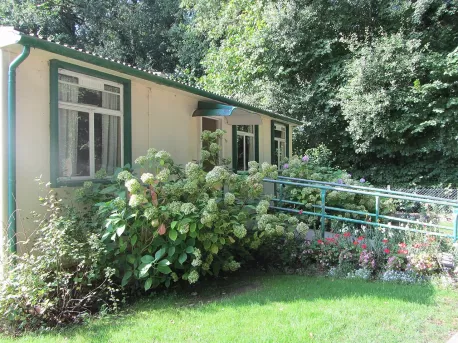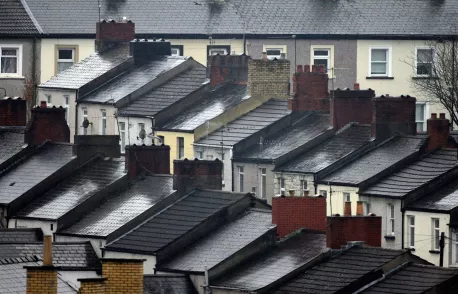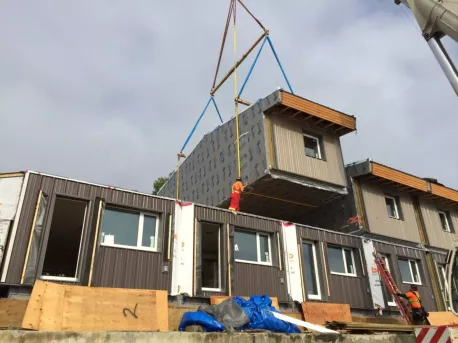Results: This survey is about Prefabs (prefabricated homes) and how American know-how helped solve the post war housing crisis in the UK.
Published on 05/13/2025
Prefabs were a major part of the plan to address the UK's post–WWII anticipated 200,000 annual shortfall in housing stock by building 500,000 prefabricated houses, with a planned life of up to 10 years. As is the norm, the target number of houses was not met however those prefabs lasted a lot longer than the 10 years. I lived in one as a child and have fond memories of that time. Perhaps prefabs have a place in today's society. Here are some features and benefits of those prefabs.

QUESTIONS
GO to COMMENTS
Comments
1.
1.
Here are some facts about prefabs that you may find interesting. Check off which ones.

Prime Minister Winston Churchill set up the committee in 1942, which sent British engineers to the United States the following year to investigate how America – one of the main wartime advocates of prefabricated construction – intended to address its needs for post-war housing.
11%
229 votes
America already had considerable experience in building prefabricated homes. Sears has been selling them since the early 1900s. All the supplies needed to construct a home were bundled together with blueprints, and shipped directly from the factory. 22 home designs were offered.
27%
558 votes
Of the 1.2 million new houses built in the UK between 1945 and 1951 when the program officially ended, 156,623 prefab houses were constructed. Today, a number survive, a testament to the durability of the designs and construction methods that were only envisaged to last 10 years.
20%
411 votes
Not Interested
43%
902 votes
2.
2.
Here are some more facts about prefabs. Which of them are of interest to you?

As the war was ending, Churchill announced the Emergency Factory Made or EFM housing program to build 500,000 'new-technology' prefabricated temporary houses directly at the end of the war: This was treated as a military campaign with private industry harnessed in its service. As much thought went into the prefabricated housing program as went into the desert campaign in Africa.
24%
494 votes
By 1951 the EFM housing program had created one million new council houses, resulting in 15 per cent of all the dwellings in Britain being state-owned, more than the proportion in the Soviet Union at that time.
23%
480 votes
The government created research institutes, standards and competition authorities that resulted in core building regulations for the first time. As a result, these prefabs were built to a higher standard of features and amenities than the typical British home of that time.
28%
586 votes
Not Interested
46%
974 votes
3.
3.
The prefab I lived in until 1953 had much to appreciate. So much so that, when the government planned to demolish these houses decades later there was significant resistance from residents. Here are some features that were a marked improvement over the typical council home of that time. Have you ever lived anywhere that didn't have these features?

All approved prefab units had to have a minimum floor space of 635 square feet and include a combined prefabricated kitchen that backed onto a bathroom. It meant that the unsightly water pipes, waste pipes and electrical distribution were all in the same place, and hence easy to install.
22%
472 votes
The house retained a coal fire, but it contained a back boiler to create both central heating as well as a constant supply of hot water.
20%
421 votes
For a country used to an outside toilet and tin bath, the bathroom included a flushing toilet and man-sized bath with hot running water. The kitchen had modern luxuries such as a built-in oven, refrigerator and water heater, features which only years later became commonplace in residential dwellings.
28%
581 votes
Not Interested
49%
1031 votes
4.
4.
Here are some additional features of these prefabs that I have fond memories of. Which of these might you have appreciated compared to some typical houses of that time (see photo).

To speed construction many were developed on the side of municipal parks and green belts, giving their residents, who had most often come from cramped rooms in inner cities, the feeling of living in the rural countryside.
23%
479 votes
All prefabs under the housing act came pre-decorated in magnolia, with gloss-green on all additional wood, including the door trimmings and skirting boards. The typical wallpaper of that time was hideous and dark. This was noticeably brighter.
20%
410 votes
These were placed on what today would be a large lot with the ability to have a lawn, vegetable plot (we still had rationing), a flower garden and a level of privacy.
26%
554 votes
British prefabs in both manufacture and construction costs combined turned out to be more costly than traditionally built brick houses while the American sourced units with more streamlined construction and higher volumes were cheaper. Even though I am Scottish, I may have been born in an "American home".
15%
314 votes
Not Interested.
48%
999 votes
5.
5.
Do you think governments should revisit prefabs as a means of solving the housing crisis?

Yes
50%
1058 votes
No
12%
247 votes
Not Interested
38%
795 votes
COMMENTS


